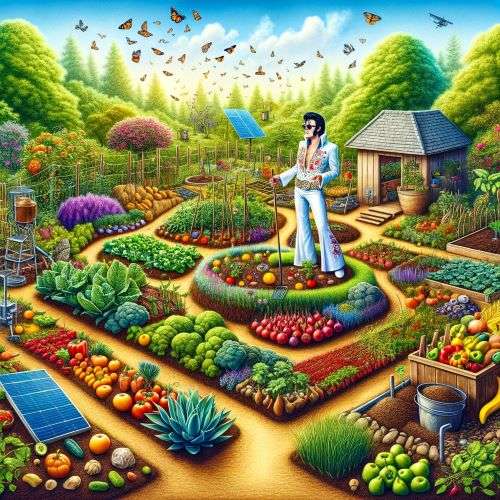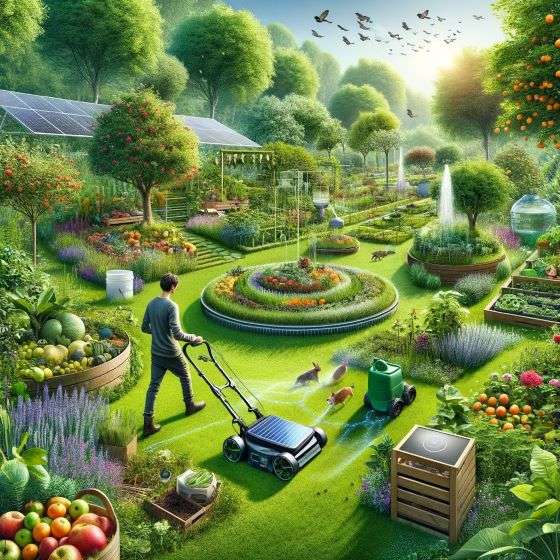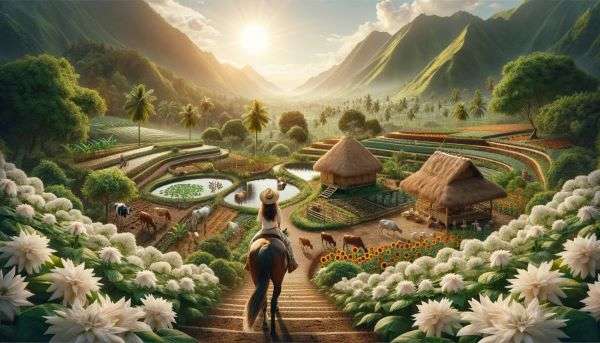This post contains affiliate links, through which we may earn a commission at no additional cost to you.
Table of Contents
Introduction
Permaculture agriculture has intricately intertwined with the ongoing discourse on ecology and sustainable practices, occasionally enveloped in a mix of eager conversations and, quite honestly, a significant amount of skepticism and puzzlement.
This forward-thinking method of farming and living, designed to foster ecosystems that sustain themselves, often receives a level of doubt paralleling the debates on whether Elvis Presley is secretly alive and well, hidden from the public eye. However, distinguishing between myths and realities in permaculture agriculture is as essential as it is intriguing. A myriad of myths about permaculture proliferates, each more elaborate than the next, mirroring the legendary stories associated with the Rock ‘n’ Roll superstar.
We gear up, don our gardening gloves, and delve into the speculative terrain to uncover the truth beneath these myths. Our expedition to demystify the most entrenched myths about permaculture agriculture will be equipped with a sense of humor as our shovel to turn over the compost heap of misunderstanding and a watering can brimming with the pristine water of truth. This task transcends merely jesting at the misconceptions or dispelling baseless rumors; it is a venture into highlighting the genuinely transformative power of permaculture agriculture.
By investigating these myths with a lighthearted approach yet anchored in verifiable facts, we aim to foster a more profound comprehension of permaculture and its significance in pursuing more sustainable and balanced coexistence with our environment. So, embark with us as we cut through the thicket of fallacies with the compass of scientific evidence and the map of firsthand experiences to showcase permaculture’s real significance and potential.
Myth 1: Permaculture Agriculture is Just Fancy Gardening
Oh, if only it were that simple! Permaculture is not just about planting a few tomatoes and calling it a day.This approach embodies a comprehensive strategy for sustainable living, harmoniously blending the use of land, resources, and human interaction with the environment. It revolves around designing an ecosystem that operates autonomously, akin to an efficient dishwasher, but with a greener, more natural approach.
Real-Life Example: The renowned Zaytuna Farm in Australia, founded by permaculture co-originator Geoff Lawton, is a living testament to this. Here, permaculture principles are applied to everything from water harvesting and soil building to animal systems and forestry.
Visiting Zaytuna farm is a must-visit destination for permaculture enthusiasts. To make your trip more convenient, consider these accommodations.
- The Channon Gallery Guesthouse: Experience artistic charm and tranquility at this guesthouse, conveniently located near Zaytuna Farm
- Riverside Holiday Apartments: For those seeking a riverside retreat, these apartments provide a serene setting to relax after exploring the farm. They are conveniently located near Zaytuna Farm.
- The Channon Gallery and Studios: If you prefer a unique artistic experience, this gallery and studio accommodation is a great choice. It’s situated in the heart of The Channon, making it accessible to Zaytuna Farm.
To reach Zaytuna Farm from The Channon or other nearby accommodations, you can hire a local taxi service or rent a car. The farm is conveniently accessible by road, and a short drive will take you to this permaculture haven in the heart of NSW, Australia.
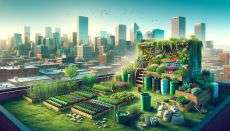
Myth 2: Permaculture Agriculture Doesn’t Work in Urban Areas
Hold onto your compost bins, city dwellers, because this is where it gets interesting! Permaculture is not just for those with sprawling acres. Urban permaculture is a thing, and it’s thriving.
Real-Life Example: Look no further than the Denver Urban Gardens in Colorado, USA, where urbanites transform small spaces into green oases. This shows that you don’t need a vast countryside to practice permaculture; a small balcony or rooftop can be your canvas.
Explore Urban Permaculture: For urban permaculture enthusiasts looking to transform their city space into an eco-haven, consider these essential books:.
- “The Urban Farmer” by Curtis Stone :This book is a valuable resource for urban permaculture enthusiasts. Curtis Stone shares practical insights and techniques for creating productive and sustainable urban gardens. Learn how to maximize your urban space and turn it into an eco-haven.
- “Permaculture in Pots: How to Grow Food in Small Urban Spaces” by Juliet Kemp: This book provides guidance on how to grow food in small urban spaces, including balconies, patios, and even windowsills. This book offers innovative solutions for urban gardeners to practice permaculture principles in limited areas.
- “The Edible City: A Year of Wild Food” by John Rensten: “The Edible City” explores the concept of foraging for wild food in urban environments. John Rensten takes readers on a journey to discover edible plants and herbs growing in cities. This book combines permaculture ideas with urban foraging to promote sustainable food practices.
Myth 3: Permaculture Agriculture is Too Complicated
Permaculture is undoubtedly a comprehensive system that incorporates numerous principles and ethical considerations, mirroring the structured approaches required in various life activities—consider the process of putting together furniture from IKEA. Despite the complex instructions and many components, many people commence the assembly process equipped with merely an Allen key and an optimistic attitude.
Though made in jest, this analogy highlights a crucial aspect of permaculture: its ease of access and adaptability. Similar to the step-by-step guidance provided in furniture assembly manuals, permaculture presents a blueprint that is, although intricate, purposely made to be versatile and adjustable to the user’s particular requirements and surroundings. This system promotes trying out new ideas, learning through errors, and, most importantly, beginning with whatever resources are available.

Real-Life Example: An exemplary demonstration of permaculture’s flexibility and accessibility is vividly displayed in the Greening the Desert Project. This initiative stands as a powerful testament to the transformative capacity of permaculture. Led by Geoff Lawton, a prominent permaculture community member, this venture is located in one of Earth’s most daunting environments—Jordan’s dry and unforgiving landscape.
The region, characterized by its severe climate, limited water supply, and poor soil quality, appears to be an improbable site for prosperous farming activities. Yet, the Greening the Desert Project shines as a lighthouse of achievable outcomes with permaculture at the core. By implementing intelligent design, effective water conservation methods, and a profound comprehension of ecological systems, the project has converted a previously desolate plot of land into a lush oasis. This remarkable transformation displays permaculture’s capability to rejuvenate devastated areas and illustrates its practical simplicity. Employing the correct techniques and carefully considering permaculture ethics and principles proves that permaculture can thrive in any setting, no matter how daunting it may appear.
This instance acts as both a source of inspiration and confirmation that permaculture isn’t simply a collection of strict regulations to adhere to; it’s a dynamic, living philosophy that molds to the needs of the terrain and those who tend to it. Whether one is an experienced gardener or a newcomer to the principles of sustainable living, permaculture offers a route to more resilient, fruitful, and ecologically harmonious ways of life. By observing nature, absorbing its lessons, and utilizing permaculture principles, we can foster ecosystems that aren’t just sustainable, but flourish. The Greening the Desert Project, provides a lucid demonstration that with permaculture, our potential to contribute positively to the planet and its future is limitless.
Educate Yourself For an excellent start, whether you’re a beginner or a seasoned pro, consider these valuable books:
1. “Rainwater Harvesting for Drylands and Beyond, Volume 3″ by Brad Lancaster : Continue your exploration of rainwater harvesting with Brad Lancaster’s third volume, which offers advanced techniques for desert climates.
2. “Desert or Paradise: Restoring Endangered Landscapes Using Water Management, Including Lake and Pond Construction” by Sepp Holzer : Discover Sepp Holzer’s strategies for creating vibrant oases in desert environments.
3.“The Dry Garden” by Beth Chatto : Beth Chatto’s book offers insights into creating beautiful, water-efficient gardens in arid climates.
These books will equip you with the knowledge and inspiration needed to make the most of your permaculture journey in desert regions, while also dispelling any common permaculture agriculture myths.
Myth 4: Permaculture Agriculture is Just a Trend
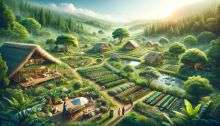
Permaculture is as much a trend as breathing is a new fad. It’s been around since the 1970s, and its principles are timeless. It’s about working with nature, rather than against it – a concept that never goes out of style.
Real-Life Example: The Crystal Waters Eco Village in Queensland, Australia, is a living, breathing example of permaculture’s longevity and success. Established in 1987, this village is a shining example of sustainable living and community resilience.
Plan a Memorable Visit: Crystal Waters isn’t just a village; it’s a remarkable experience. For a unique stay, consider the Crystal Waters Eco Lodge, where you can fully immerse yourself in a community dedicated to permaculture. However, if you prefer different accommodations, here are two excellent options:
- Narrows Escape Rainforest Retreat
- Distance from Crystal Waters Eco Village: Approximately 11.2 miles
- Description: This retreat is nestled in a serene rainforest setting, perfect for nature enthusiasts seeking tranquility. It’s a great choice for those who want to experience the rainforest while staying relatively close to Crystal Waters Eco Village.
2. Kondalilla Eco Resort
- Distance from Crystal Waters Eco Village: Approximately 11 miles
- Description: Kondalilla Eco Resort offers eco-friendly accommodations amidst the stunning Sunshine Coast Hinterland. It’s an ideal option for those who wish to stay in proximity to Crystal Waters and explore the natural beauty of the surroundings.
These accommodations provide diverse experiences, ensuring your visit to the Crystal Waters area is both comfortable and memorable.
Conclusion
So, there you have it – four permaculture myths, thoroughly busted. Whether you’re a city slicker with a window box or a rural dweller with acres to spare, permaculture is accessible, sustainable, and definitely not just a passing trend. It’s a way of life that respects the earth and all its inhabitants. Now, go forth and turn your space, be it big or small, into a permaculture paradise!
FAQ
Is permaculture agriculture all about lazy gardening?
It is not about laziness but rather efficient and sustainable design. It involves strategic planning and thoughtful use of natural resources.
Is permaculture agriculture a fixed set of rules?
It is a flexible framework, not a rigid set of rules. It encourages adaptation to local conditions and the integration of diverse ideas and techniques, effectively debunking any permaculture myths you may have heard about its limitations.
What is the smallest amount of land needed to practice permaculture?
It can be adapted to even the smallest of spaces, such as a balcony or a modest backyard, incorporating sustainability practices at any scale.
What the barriers of permaculture agriculture?
Initial setup costs, the need for specific knowledge and skills, and the time required for systems to become established.

